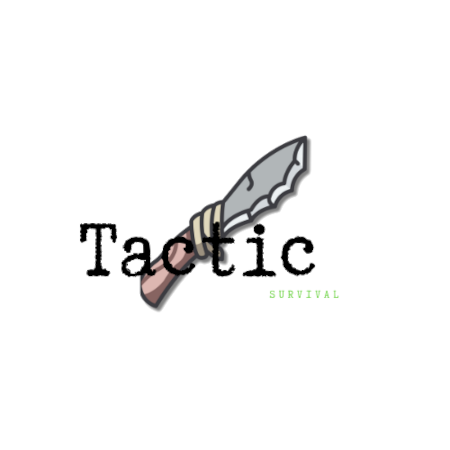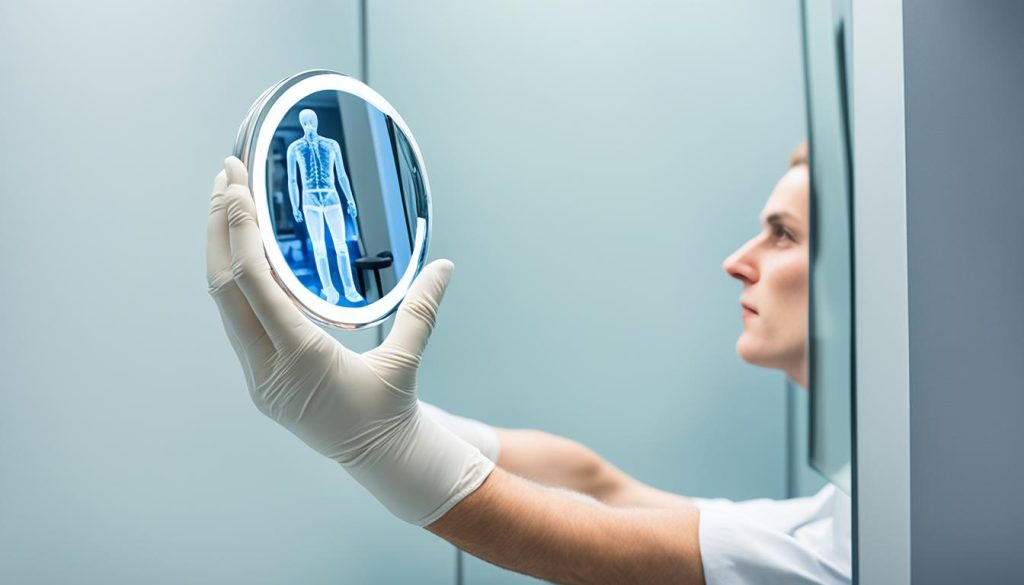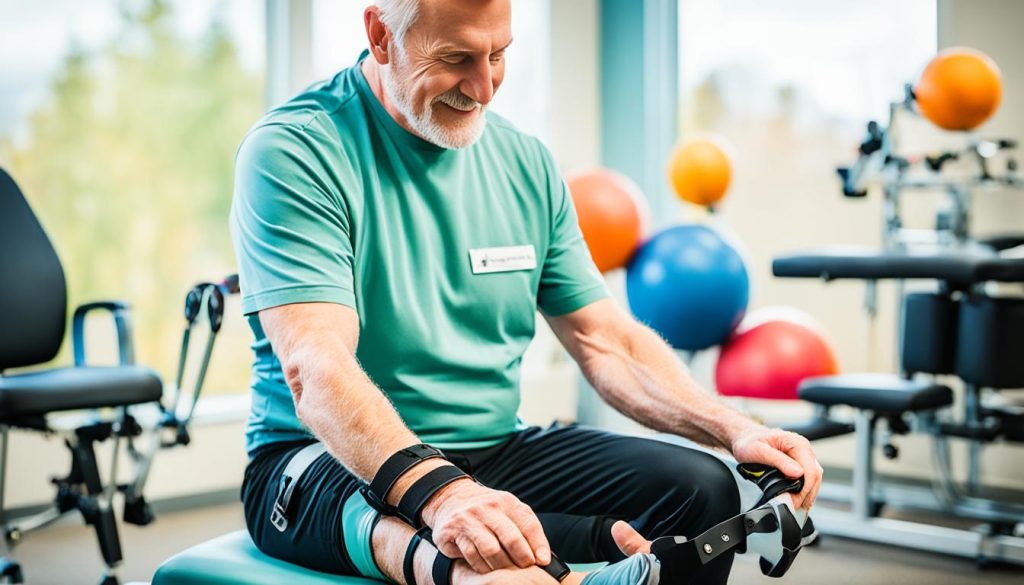Did you know about 45% of amputations come from traumatic injuries? And, about 54% stem from vascular diseases like diabetes. Amputation is the loss of a body part, either through trauma or surgery. It has a big effect on a person’s life.
Several things can lead to amputations. These include accidents, injuries, vascular diseases, cancer, and bad infections. How an amputation is done depends on the body part involved and how much damage there is. Teams of surgeons, nurses, and technologists work together to help people who need amputations.
Key Takeaways:
- Approximately 45% of amputations are due to traumatic injuries, while about 54% are a result of complications from vascular diseases like diabetes.
- Amputations can result from various causes such as accidents, injuries, vascular diseases, cancer, and severe infections.
- The surgical approach to amputation depends on the affected body part and the extent of tissue damage.
- Orthopaedic and reconstructive surgeons, along with nurses and technologists, form a surgical amputation team.
- Comprehensive care is essential for individuals undergoing amputation.
Causes and Types of Amputation
Amputations can be from accidents or the need for surgery due to illnesses like cancer. They also happen because of serious infections. For upper body part amputations, some common ones include losing parts of your hand, arm, or even a shoulder.
- Partial hand amputation
- Below-the-elbow amputation
- Shoulder disarticulation
Leg amputations often mean losing part of the foot, below the knee, or even at the hip. Each case needs different kinds of help for the person to get better after losing a limb. This includes taking care of the place where the limb was.
- Partial foot amputation
- Below-the-knee amputation
- Hip disarticulation
To get back on your feet after an amputation, proper care and support are critical. This means taking care of the wound and avoiding problems. Caring for the area where the limb used to be is very important for healing.
Post-Amputation Rehabilitation
After losing a limb, recovery isn’t just physical. It’s also about feeling and doing better. The journey to getting well includes different kinds of therapy, like:
- Physical therapy: Focuses on strengthening the muscles, improving mobility, and promoting functional independence.
- Occupational therapy: Aims to improve daily living skills, such as self-care and performing essential tasks.
- Pain management: Helps alleviate any residual pain or discomfort associated with the amputation.
Teamwork is key in amputees’ recovery. Doctors, therapists, and others work together to help in all areas of life.
Stump Care and Wound Healing
Taking good care of the area where a limb was cut off is very important. It helps the wound heal well and avoids future problems. This care includes:
- Regular cleaning and hygiene maintenance of the residual limb to prevent infections.
- Appropriate dressing application to protect the wound and promote healing.
- Monitoring for any signs of skin breakdown or pressure ulcers.
By taking good care of the stump, the chance of getting an infection goes down. Also, the wound can heal faster this way. It’s really key to avoid problems later.
Complications and Prevention
Even with careful care, some issues can still happen after losing a limb. This includes feeling pain, even though the limb is gone, or feeling like the limb is still there. Other problems might be muscle tightness or ongoing pain in the stump.
- Phantom limb pain and sensation: A phenomenon where individuals experience sensations or pain in the amputated limb.
- Contractures: The tightening and shortening of muscles, resulting in limited joint range of motion.
- Pain-related issues: Persistent or chronic pain associated with the residual limb.
To deal with these problems, doctors and therapists use many different methods. This can include medicines, exercises, and other types of treatment to make the person feel better.
| Type of Amputation | Care Needs |
|---|---|
| Partial hand amputation | Customized prosthetic device fitting, stump care, and rehabilitation. |
| Below-the-elbow amputation | Prosthetic limb fitting, stump care, physical therapy, and occupational therapy. |
| Shoulder disarticulation | Complex prosthetic limb fitting, stump care, rehabilitation, and psychological support. |
| Partial foot amputation | Prosthetic footwear, regular foot care, and physical therapy. |
| Below-the-knee amputation | Prosthetic limb fitting, stump care, gait training, and rehabilitation exercises. |
| Hip disarticulation | Advanced prosthetic limb fitting, stump care, physical therapy, and lifestyle adaptations. |
Rehabilitation and Prosthetic Fitting
Rehabilitation is key in helping people adjust to life after losing a limb. It covers many crucial areas:
- Physical therapy: Physical therapy is important post-amputation. It helps in recovery by improving muscle strength, flexibility, and movement. Physical therapists work with amputees to help them move better and feel more in control of their bodies.
- Occupational therapy: Occupational therapists aid amputees in everyday tasks. This includes skills like getting dressed, cooking, and using tools. They help improve independence and life quality by teaching useful methods.
- Pain management: Pain control is vital for amputees. Doctors create plans to reduce both short-term and long-lasting pain. This might involve meds, therapy, or other techniques to manage pain and make life more comfortable.
- Psychosocial adjustment: Losing a limb is both physical and emotional. Mental health experts help amputees deal with the tough parts. They provide the support needed for a smooth recovery and life adjustment.
Prosthetic Limb Fitting
Fitting a prosthetic limb is a key part of the recovery plan. It’s about choosing, customizing, and properly fitting the prosthetic. The goal is to help amputees regain movement and independence.
“Prosthetic limb fitting allows individuals to regain mobility and independence, enabling them to engage in various activities and improve their overall quality of life.”
The fitting process starts by evaluating the limb and deciding what’s needed. Then, the prosthesis is crafted to be both functional and comfy. The team ensures it fits right and teaches how to use it properly.
The aim is a well-fitted prosthetic limb that betters mobility and life quality. Technology is always improving, offering more options and enhancing life for those with limb loss.
| Benefits of Prosthetic Limb Fitting | Challenges of Prosthetic Limb Fitting |
|---|---|
|
|
Yet, fitting a prosthetic limb isn’t without challenges. Open communication with the rehab team is crucial to tackle these hurdles. This ensures a smoother inclusion of the prosthetic in daily life.
With the right rehab and fitting, amputees can beat their physical limits. Each person’s recovery is a personal journey. The rehab team is there to support and help throughout.
Complications and Support
After losing a limb, people might feel pain or strange sensations where the limb used to be. This is called phantom limb pain. It can affect both their body and mind, making it tough to keep a positive outlook.
Helping them manage this pain is key. Doctors use different methods, like pills and non-traditional treatments, to lessen the ache. This step is crucial for the person’s comfort and well-being.
Phantom limb pain is quite bothersome and can really lower a person’s quality of life. Quick and effective support is vital. It helps lessen the distress, making life better for those dealing with this issue.
While physical issues are important, the mental side matters too. Support from other amputees helps a lot in handling life changes. It boosts mental health, which is as crucial as healing the body.
Joining a support group lets individuals share their stories with others who understand. It offers practical tips and empathy. This helps in facing the daily struggles of being an amputee.
Talking to a counselor is also beneficial. They help deal with the feelings of loss and change. Programs on prosthetics and daily care also provide valuable info. They help in living the best life possible post-amputation.
Benefits of Amputee Support:
- Emotional support from individuals with similar experiences
- Practical guidance for daily activities and overcoming obstacles
- Access to information about prosthetic technologies and advancements
- Opportunities to share coping strategies and success stories
- Networking and social connections
- Encouragement and motivation to pursue personal goals
Comparison of Phantom Limb Pain Management Approaches
| Treatment | Description | Effectiveness |
|---|---|---|
| Medications | Prescription drugs to help with nerve pain and symptoms | Sometimes offers relief, but not for everyone |
| Alternative Therapies | Methods like TENS, mirror therapy, acupuncture, and hypnosis | Can help some people, but it varies |
| Cognitive-Behavioral Therapy (CBT) | Therapy to change negative thoughts and learn coping skills | Known to reduce pain and improve well-being |
| Virtual Reality (VR) Therapy | Using virtual reality for pain distraction | Shows promise in easing phantom limb pain |
Support and solutions are the key to managing amputation challenges. Phantom limb pain and emotional support are vital. They help in the overall recovery, improving life for amputees.
Self-Management and Care
Self-management is key in amputation recovery and care over the long term. It helps people take charge of their healing. This leads to improved results and happiness. A good self-management plan boosts both physical and emotional recovery.
Adherence to Medications
Taking medicines as directed is a big part of self-management. This might mean pain relievers, antibiotics, or other meds. Sticking to the medication schedule is crucial. It helps the body heal right and avoids problems.
Wound Care
Taking care of the wound is very important. Cleaning and changing dressings often, as told by doctors, is a must. It helps the wound heal without getting infected. Amputees must listen to their healthcare team for the best care.
Rehabilitation Exercises
Doing the recommended exercises is vital. This helps in getting back strength and moving better. The sessions are made just for you and your needs. They make amputation recovery and using prosthetics easier. It is essential to do these exercises regularly to see improvements.
Lifestyle Modifications
After amputation, life may change a lot. People need to adjust for their health and happiness. This might mean changing how they do things every day or adding special tools. These changes are different for everyone but can really make life better.
Education and Support
To self-manage, you need to learn and get support. Knowing about therapy, what to expect, and what problems can come up is very empowering. Connecting with others in similar situations or getting counseling is also great. It helps in dealing with the challenges and offering support.
“It is important for amputees to actively engage in self-management strategies to optimize their recovery and long-term care.”
Focusing on medicines, wound care, exercises, lifestyle changes, and learning/getting support helps a lot. They allow people to lead their amputation recovery in a positive way.
| Benefits of Self-Management | Strategies for Effective Self-Management |
|---|---|
|
|
Stump Care and Complications
Caring for a stump after amputation is very important. It helps the wound heal and stops infections. This care is key to a successful recovery for people who have lost a limb. Proper care also stops many issues from happening later on.
Keeping the stump clean is a big part of care. Wash it often with mild soap to get rid of germs. Then dry it well to avoid problems caused by too much moisture.
Using the right bandages is also crucial. A soft bandage should cover the area. For an upper limb or a leg below the knee, a 10 cm bandage is used. Above the knee, use a 15 cm bandage. Change these bandages often to keep the area clean. Your doctor will tell you how to do this.
| Complication | Preventive Measures |
|---|---|
| Pressure Ulcers | Change how you sit or lie down often to avoid putting pressure on the stump. Special cushions help spread the pressure out. |
| Infections | Stay clean and dry. Tell your doctor right away if you see any signs of infection, like redness or swelling. |
| Edema and Hematomas | Use rigid dressings to help stop fluid buildup and bruising. Your doctor will guide you on how to use them. |
Watch the stump closely for any issues. If you notice anything strange, like a color change, tell your healthcare team immediately. Acting fast can prevent problems from getting serious.
There are techniques to help with pain after amputation. A study found that massaging the stump and gently tapping it can lower pain after surgery. It also reduces anxiety and depression. These methods are proven to be helpful.
Good stump care is vital for a smooth recovery. It includes keeping the stump clean, using the right bandages, and watching for any changes. Following these steps greatly improves your health after an amputation.
Conclusion
Amputation management is complex and involves many specialists. This approach includes surgical teams, rehab experts, and support groups. With proper care, people can recover well and improve their lives after losing a limb.
Research shows saving limbs is crucial and that making smart treatment choices matters a lot. For example, a study looked at the costs and benefits of saving a limb versus amputation after open tibial fractures. It also looked into a tool to help decide which treatment is best for a patient.
The part of the journey after amputation is vital. It helps people get used to prosthetics, deal with any health issues, and get emotional support. This way, those who’ve lost a limb can feel better and do well as they adjust to their new situation.
As we learn more and do better in managing amputations, our main goal is to help patients. This means improving their care, making treatments work better, and helping them in the longer term. By sticking to what’s been proven to work and focusing on what patients need, we can make a difference in their recovery and lives.


